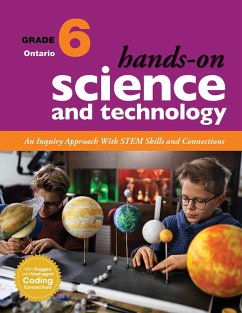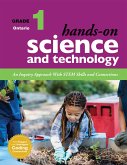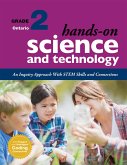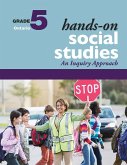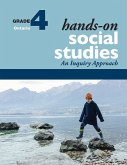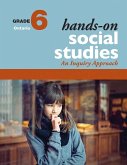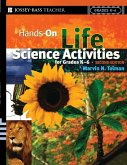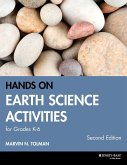Jennifer E Lawson
Hands-On Science and Technology for Ontario, Grade 6
An Inquiry Approach with Stem Skills and Connections
123,99 €
inkl. MwSt.
Versandkostenfrei*
Erscheint vorauss. 6. Januar 2026
Melden Sie sich
hier
hier
für den Produktalarm an, um über die Verfügbarkeit des Produkts informiert zu werden.

62 °P sammeln
Jennifer E Lawson
Hands-On Science and Technology for Ontario, Grade 6
An Inquiry Approach with Stem Skills and Connections
- Broschiertes Buch
Teach coding with confidence in grade 6 using lesson plans custom-written for Ontario's science and technology (2022) curriculum. Using proven Hands-On features, this book provides resources for both teachers and students including background information on the science topics; complete, easy-to-follow lesson plans; materials lists; and digital image banks and reproducibles.
Andere Kunden interessierten sich auch für
![Hands-On Science and Technology for Ontario, Grade 1 Hands-On Science and Technology for Ontario, Grade 1]() Jennifer E LawsonHands-On Science and Technology for Ontario, Grade 1133,99 €
Jennifer E LawsonHands-On Science and Technology for Ontario, Grade 1133,99 €![Hands-On Science and Technology for Ontario, Grade 2 Hands-On Science and Technology for Ontario, Grade 2]() Jennifer E LawsonHands-On Science and Technology for Ontario, Grade 2131,99 €
Jennifer E LawsonHands-On Science and Technology for Ontario, Grade 2131,99 €![Hands-On Social Studies for Ontario, Grade 5 Hands-On Social Studies for Ontario, Grade 5]() Jennifer E LawsonHands-On Social Studies for Ontario, Grade 5123,99 €
Jennifer E LawsonHands-On Social Studies for Ontario, Grade 5123,99 €![Hands-On Social Studies for Ontario, Grade 4 Hands-On Social Studies for Ontario, Grade 4]() Jennifer E LawsonHands-On Social Studies for Ontario, Grade 4123,99 €
Jennifer E LawsonHands-On Social Studies for Ontario, Grade 4123,99 €![Hands-On Social Studies for Ontario, Grade 6 Hands-On Social Studies for Ontario, Grade 6]() Jennifer E LawsonHands-On Social Studies for Ontario, Grade 6126,99 €
Jennifer E LawsonHands-On Social Studies for Ontario, Grade 6126,99 €![Hands-On Life Science Activities for Grades K-6 Hands-On Life Science Activities for Grades K-6]() Marvin N TolmanHands-On Life Science Activities for Grades K-632,99 €
Marvin N TolmanHands-On Life Science Activities for Grades K-632,99 €![Hands-On Earth Science Activities for Grades K-6 Hands-On Earth Science Activities for Grades K-6]() Marvin N TolmanHands-On Earth Science Activities for Grades K-629,99 €
Marvin N TolmanHands-On Earth Science Activities for Grades K-629,99 €-
-
-
Teach coding with confidence in grade 6 using lesson plans custom-written for Ontario's science and technology (2022) curriculum. Using proven Hands-On features, this book provides resources for both teachers and students including background information on the science topics; complete, easy-to-follow lesson plans; materials lists; and digital image banks and reproducibles.
Hinweis: Dieser Artikel kann nur an eine deutsche Lieferadresse ausgeliefert werden.
Hinweis: Dieser Artikel kann nur an eine deutsche Lieferadresse ausgeliefert werden.
Produktdetails
- Produktdetails
- Verlag: Portage & Main Press
- New Edition, Updated & Revised edition
- Seitenzahl: 359
- Erscheinungstermin: 6. Januar 2026
- Englisch
- Abmessung: 279mm x 216mm x 38mm
- Gewicht: 857g
- ISBN-13: 9781774920718
- ISBN-10: 1774920719
- Artikelnr.: 70453785
- Herstellerkennzeichnung
- Libri GmbH
- Europaallee 1
- 36244 Bad Hersfeld
- gpsr@libri.de
- Verlag: Portage & Main Press
- New Edition, Updated & Revised edition
- Seitenzahl: 359
- Erscheinungstermin: 6. Januar 2026
- Englisch
- Abmessung: 279mm x 216mm x 38mm
- Gewicht: 857g
- ISBN-13: 9781774920718
- ISBN-10: 1774920719
- Artikelnr.: 70453785
- Herstellerkennzeichnung
- Libri GmbH
- Europaallee 1
- 36244 Bad Hersfeld
- gpsr@libri.de
Jennifer E. Lawson, PhD, is the creator of the Hands-On books published by Portage & Main Press. As senior writer and editor for the series, she has contributed to more than 50 publications for teachers and students. Jennifer provides professional development workshops for educators locally, nationally, and virtually, and is a Workplace Wellness Advisor. Her most recent book is a collective effort called Teacher, Take Care: A Guide to Well-Being and Workplace Wellness for Educators. She is also one of the founders of Mission to Mexico, an organization that supports schools in some of the most impoverished communities in Puerto Vallarta. Throughout her extensive career in education, Jennifer has worked as a classroom teacher, resource and special education teacher, consultant, principal, university instructor, and school trustee. She lives with her family in Winnipeg, Manitoba.
Introduction to Hands-On Science and Technology for Ontario, Grade 6 1
* Introduction to Hands-On Science and Technology 2
* Program Introduction 2
* The Inquiry Approach to Science and Technology 2
* 21st Century Teaching and Learning 3
* The Goals of the Science and Technology Program 3
* Hands-On Science and Technology Strands and Expectations 4
* Hands-On Science and Technology Fundamental Concepts and Big Ideas 4
* Hands-On Science and Technology Program Principles 5
* Infusing Indigenous Perspectives 5
* Cultural Connections 7
* Land-Based Learning 7
* Technology 7
* Sustainability 7
* Program Implementation 8
* Program Resources 8
* Classroom Environment 11
* Planning Units—Timelines 12
* Classroom Management 12
* Classroom Safety 12
* Scientific Inquiry Skills: Guidelines for Teachers 12
* Observing 12
* Questioning 13
* Exploring 13
* Classifying 13
* Measuring 14
* Communicating, Analyzing, and Interpreting 14
* Predicting 16
* Inferring 17
* Inquiry Through Investigation and Experiments 17
* Inquiry Through Research 17
* Online Considerations 18
* Addressing Students’ Literacy Needs 18
* Technological Problem Solving 19
* Makerspace 19
The Hands-On Science and Technology Assessment Plan 22
* Assessment for Learning 23
* Assessment as Learning 23
* Assessment of Learning 24
* Performance Assessment 25
* Portfolios 25
* Evidence of Student Achievement Levels for Evaluation 26
* Important Note to Teachers 26
* References 27
* Assessment Reproducibles 28
* Achievement Chart for Science & Technology 43
Unit 1: Biodiversity 45
1. Introduction 46
2. Unit Overview 50
3. Curriculum Correlation 51
4. Resources for Students 52
* 1 What Do We Know About the Diversity of Living Things? 55
* 2 How Can We Show Classification Systems in Different Ways? 60
* 3 How Is the Animal Kingdom Organized? 65
* 4 How Can We Compare and Contrast Animals? 71.
* 5 What Can We Learn by Investigating an Arthropod Colony? 78
* 6 What Are Characteristics of Organisms in the Plant Kingdom? 84
* 7 How Do Living Things Adapt to Survive in Their Environment? 88
* 8 What Can We Learn About Organisms Through a Pond Study? 92
* 9 What Are Bacteria? 99
* 10 What Is a Fungus? 103
* 11 What Are Some Benefits and Issues Related to Biodiversity? 107
* 12 Inquiry Project: How Can I Use Technological Problem-Solving
Skills to Explore the Diversity of Living Things? 112
Unit 2: Flight 115
5. Introduction 116
6. Unit Overview 119
7. Curriculum Correlation 120
8. Resources for Students 121
* 1 How Do Organisms and Other Objects Move Through Air? 124
* 2 What Are the Properties of Air? 130
* 3 What Are the Features of Lighter-Than-Air Flying Devices? 138
* 4 What Is Bernoulli’s Principle? 144
* 5 How Is Bernoulli’s Principle Used in the Design of Airplane Wings?
150
* 6 What Are the Forces Affecting Flight? 155
* 7 How Are Unbalanced Forces Used to Steer Flying Devices? 163
* 8 How Is Pneumatic Power Used in Flight? 169
* 9 How Can We Design and Construct Model Aircraft to Meet Certain
Criteria? 173
* 10 Inquiry Project: What Is the Environmental Impact of Aviation
Technology? 177
Unit 3: Electricity and Electrical Devices 181
9. Introduction 182
10. Unit Overview 185
11. Curriculum Correlation 186
12. Resources for Students 187
* 1 What Do We Know About Electricity? 190
* 2 What Is Static Electricity? 194
* 3 What Is Current Electricity? 201
* 4 How Do We Get Electricity From Chemical Sources? 205
* 5 How Do Electric Circuits Work? 211
* 6 What Are Electrical Conductors and Insulators? 215
* 7 How Do Electrical Switches Work? 219
* 8 What Do We Know About Parallel and Series Circuits? 222
* 9 How Can We Design and Construct an Electrical Device to Perform a
Useful Function? 228
* 10 How Can We Construct an Electromagnet? 231
* 11 How Do Motors and Generators Transform Energy? 235
* 12 What Is the Environmental Impact of Using Electricity? 241
* 13 How Can We Reduce the Environmental Impact of Using Electricity?
247
* 14 Inquiry Project: What More Do I Want to Know About Electricity?
253
Unit 4: Space 257
13. Introduction 258
14. Unit Overview 262
15. Curriculum Correlation 263
16. Resources for Students 264
* 1 What Do We Know About Space? 268
* 2 What Are the Features of Our Solar System? 272
* 3 What Are the Characteristics of the Planets in Our Solar System?
277
* 4 What Are the Characteristics of the Sun? 283
* 5 Why Do We Have a Day/Night Cycle? 287
* 6 Why Do We Have a Year Cycle? 291
* 7 How Can We Use the Sun to Tell Time? 295
* 8 What Is the Surface of the Moon Like? 299
* 9 What Are Gravity, Mass, and Weight? 303
* 10 What Are the Phases of the Moon? 308
* 11 What Is a Lunar Eclipse? 312
* 12 What Are Constellations? 315
* 13 What Can We Learn About Space Exploration? 319
* 14 How Have Canadians Contributed to Space Science and Technology?
323
* 15 How Has Space Exploration Contributed to Daily Life on Earth? 327
* 16 What Are the Advantages and Disadvantages of Space Exploration?
331
* 17 Inquiry Project: What More Do I Want to Know About Space? 335
17. References 339
Appendix: Image Banks 341
About the Contributors 352
* Introduction to Hands-On Science and Technology 2
* Program Introduction 2
* The Inquiry Approach to Science and Technology 2
* 21st Century Teaching and Learning 3
* The Goals of the Science and Technology Program 3
* Hands-On Science and Technology Strands and Expectations 4
* Hands-On Science and Technology Fundamental Concepts and Big Ideas 4
* Hands-On Science and Technology Program Principles 5
* Infusing Indigenous Perspectives 5
* Cultural Connections 7
* Land-Based Learning 7
* Technology 7
* Sustainability 7
* Program Implementation 8
* Program Resources 8
* Classroom Environment 11
* Planning Units—Timelines 12
* Classroom Management 12
* Classroom Safety 12
* Scientific Inquiry Skills: Guidelines for Teachers 12
* Observing 12
* Questioning 13
* Exploring 13
* Classifying 13
* Measuring 14
* Communicating, Analyzing, and Interpreting 14
* Predicting 16
* Inferring 17
* Inquiry Through Investigation and Experiments 17
* Inquiry Through Research 17
* Online Considerations 18
* Addressing Students’ Literacy Needs 18
* Technological Problem Solving 19
* Makerspace 19
The Hands-On Science and Technology Assessment Plan 22
* Assessment for Learning 23
* Assessment as Learning 23
* Assessment of Learning 24
* Performance Assessment 25
* Portfolios 25
* Evidence of Student Achievement Levels for Evaluation 26
* Important Note to Teachers 26
* References 27
* Assessment Reproducibles 28
* Achievement Chart for Science & Technology 43
Unit 1: Biodiversity 45
1. Introduction 46
2. Unit Overview 50
3. Curriculum Correlation 51
4. Resources for Students 52
* 1 What Do We Know About the Diversity of Living Things? 55
* 2 How Can We Show Classification Systems in Different Ways? 60
* 3 How Is the Animal Kingdom Organized? 65
* 4 How Can We Compare and Contrast Animals? 71.
* 5 What Can We Learn by Investigating an Arthropod Colony? 78
* 6 What Are Characteristics of Organisms in the Plant Kingdom? 84
* 7 How Do Living Things Adapt to Survive in Their Environment? 88
* 8 What Can We Learn About Organisms Through a Pond Study? 92
* 9 What Are Bacteria? 99
* 10 What Is a Fungus? 103
* 11 What Are Some Benefits and Issues Related to Biodiversity? 107
* 12 Inquiry Project: How Can I Use Technological Problem-Solving
Skills to Explore the Diversity of Living Things? 112
Unit 2: Flight 115
5. Introduction 116
6. Unit Overview 119
7. Curriculum Correlation 120
8. Resources for Students 121
* 1 How Do Organisms and Other Objects Move Through Air? 124
* 2 What Are the Properties of Air? 130
* 3 What Are the Features of Lighter-Than-Air Flying Devices? 138
* 4 What Is Bernoulli’s Principle? 144
* 5 How Is Bernoulli’s Principle Used in the Design of Airplane Wings?
150
* 6 What Are the Forces Affecting Flight? 155
* 7 How Are Unbalanced Forces Used to Steer Flying Devices? 163
* 8 How Is Pneumatic Power Used in Flight? 169
* 9 How Can We Design and Construct Model Aircraft to Meet Certain
Criteria? 173
* 10 Inquiry Project: What Is the Environmental Impact of Aviation
Technology? 177
Unit 3: Electricity and Electrical Devices 181
9. Introduction 182
10. Unit Overview 185
11. Curriculum Correlation 186
12. Resources for Students 187
* 1 What Do We Know About Electricity? 190
* 2 What Is Static Electricity? 194
* 3 What Is Current Electricity? 201
* 4 How Do We Get Electricity From Chemical Sources? 205
* 5 How Do Electric Circuits Work? 211
* 6 What Are Electrical Conductors and Insulators? 215
* 7 How Do Electrical Switches Work? 219
* 8 What Do We Know About Parallel and Series Circuits? 222
* 9 How Can We Design and Construct an Electrical Device to Perform a
Useful Function? 228
* 10 How Can We Construct an Electromagnet? 231
* 11 How Do Motors and Generators Transform Energy? 235
* 12 What Is the Environmental Impact of Using Electricity? 241
* 13 How Can We Reduce the Environmental Impact of Using Electricity?
247
* 14 Inquiry Project: What More Do I Want to Know About Electricity?
253
Unit 4: Space 257
13. Introduction 258
14. Unit Overview 262
15. Curriculum Correlation 263
16. Resources for Students 264
* 1 What Do We Know About Space? 268
* 2 What Are the Features of Our Solar System? 272
* 3 What Are the Characteristics of the Planets in Our Solar System?
277
* 4 What Are the Characteristics of the Sun? 283
* 5 Why Do We Have a Day/Night Cycle? 287
* 6 Why Do We Have a Year Cycle? 291
* 7 How Can We Use the Sun to Tell Time? 295
* 8 What Is the Surface of the Moon Like? 299
* 9 What Are Gravity, Mass, and Weight? 303
* 10 What Are the Phases of the Moon? 308
* 11 What Is a Lunar Eclipse? 312
* 12 What Are Constellations? 315
* 13 What Can We Learn About Space Exploration? 319
* 14 How Have Canadians Contributed to Space Science and Technology?
323
* 15 How Has Space Exploration Contributed to Daily Life on Earth? 327
* 16 What Are the Advantages and Disadvantages of Space Exploration?
331
* 17 Inquiry Project: What More Do I Want to Know About Space? 335
17. References 339
Appendix: Image Banks 341
About the Contributors 352
Introduction to Hands-On Science and Technology for Ontario, Grade 6 1
* Introduction to Hands-On Science and Technology 2
* Program Introduction 2
* The Inquiry Approach to Science and Technology 2
* 21st Century Teaching and Learning 3
* The Goals of the Science and Technology Program 3
* Hands-On Science and Technology Strands and Expectations 4
* Hands-On Science and Technology Fundamental Concepts and Big Ideas 4
* Hands-On Science and Technology Program Principles 5
* Infusing Indigenous Perspectives 5
* Cultural Connections 7
* Land-Based Learning 7
* Technology 7
* Sustainability 7
* Program Implementation 8
* Program Resources 8
* Classroom Environment 11
* Planning Units—Timelines 12
* Classroom Management 12
* Classroom Safety 12
* Scientific Inquiry Skills: Guidelines for Teachers 12
* Observing 12
* Questioning 13
* Exploring 13
* Classifying 13
* Measuring 14
* Communicating, Analyzing, and Interpreting 14
* Predicting 16
* Inferring 17
* Inquiry Through Investigation and Experiments 17
* Inquiry Through Research 17
* Online Considerations 18
* Addressing Students’ Literacy Needs 18
* Technological Problem Solving 19
* Makerspace 19
The Hands-On Science and Technology Assessment Plan 22
* Assessment for Learning 23
* Assessment as Learning 23
* Assessment of Learning 24
* Performance Assessment 25
* Portfolios 25
* Evidence of Student Achievement Levels for Evaluation 26
* Important Note to Teachers 26
* References 27
* Assessment Reproducibles 28
* Achievement Chart for Science & Technology 43
Unit 1: Biodiversity 45
1. Introduction 46
2. Unit Overview 50
3. Curriculum Correlation 51
4. Resources for Students 52
* 1 What Do We Know About the Diversity of Living Things? 55
* 2 How Can We Show Classification Systems in Different Ways? 60
* 3 How Is the Animal Kingdom Organized? 65
* 4 How Can We Compare and Contrast Animals? 71.
* 5 What Can We Learn by Investigating an Arthropod Colony? 78
* 6 What Are Characteristics of Organisms in the Plant Kingdom? 84
* 7 How Do Living Things Adapt to Survive in Their Environment? 88
* 8 What Can We Learn About Organisms Through a Pond Study? 92
* 9 What Are Bacteria? 99
* 10 What Is a Fungus? 103
* 11 What Are Some Benefits and Issues Related to Biodiversity? 107
* 12 Inquiry Project: How Can I Use Technological Problem-Solving
Skills to Explore the Diversity of Living Things? 112
Unit 2: Flight 115
5. Introduction 116
6. Unit Overview 119
7. Curriculum Correlation 120
8. Resources for Students 121
* 1 How Do Organisms and Other Objects Move Through Air? 124
* 2 What Are the Properties of Air? 130
* 3 What Are the Features of Lighter-Than-Air Flying Devices? 138
* 4 What Is Bernoulli’s Principle? 144
* 5 How Is Bernoulli’s Principle Used in the Design of Airplane Wings?
150
* 6 What Are the Forces Affecting Flight? 155
* 7 How Are Unbalanced Forces Used to Steer Flying Devices? 163
* 8 How Is Pneumatic Power Used in Flight? 169
* 9 How Can We Design and Construct Model Aircraft to Meet Certain
Criteria? 173
* 10 Inquiry Project: What Is the Environmental Impact of Aviation
Technology? 177
Unit 3: Electricity and Electrical Devices 181
9. Introduction 182
10. Unit Overview 185
11. Curriculum Correlation 186
12. Resources for Students 187
* 1 What Do We Know About Electricity? 190
* 2 What Is Static Electricity? 194
* 3 What Is Current Electricity? 201
* 4 How Do We Get Electricity From Chemical Sources? 205
* 5 How Do Electric Circuits Work? 211
* 6 What Are Electrical Conductors and Insulators? 215
* 7 How Do Electrical Switches Work? 219
* 8 What Do We Know About Parallel and Series Circuits? 222
* 9 How Can We Design and Construct an Electrical Device to Perform a
Useful Function? 228
* 10 How Can We Construct an Electromagnet? 231
* 11 How Do Motors and Generators Transform Energy? 235
* 12 What Is the Environmental Impact of Using Electricity? 241
* 13 How Can We Reduce the Environmental Impact of Using Electricity?
247
* 14 Inquiry Project: What More Do I Want to Know About Electricity?
253
Unit 4: Space 257
13. Introduction 258
14. Unit Overview 262
15. Curriculum Correlation 263
16. Resources for Students 264
* 1 What Do We Know About Space? 268
* 2 What Are the Features of Our Solar System? 272
* 3 What Are the Characteristics of the Planets in Our Solar System?
277
* 4 What Are the Characteristics of the Sun? 283
* 5 Why Do We Have a Day/Night Cycle? 287
* 6 Why Do We Have a Year Cycle? 291
* 7 How Can We Use the Sun to Tell Time? 295
* 8 What Is the Surface of the Moon Like? 299
* 9 What Are Gravity, Mass, and Weight? 303
* 10 What Are the Phases of the Moon? 308
* 11 What Is a Lunar Eclipse? 312
* 12 What Are Constellations? 315
* 13 What Can We Learn About Space Exploration? 319
* 14 How Have Canadians Contributed to Space Science and Technology?
323
* 15 How Has Space Exploration Contributed to Daily Life on Earth? 327
* 16 What Are the Advantages and Disadvantages of Space Exploration?
331
* 17 Inquiry Project: What More Do I Want to Know About Space? 335
17. References 339
Appendix: Image Banks 341
About the Contributors 352
* Introduction to Hands-On Science and Technology 2
* Program Introduction 2
* The Inquiry Approach to Science and Technology 2
* 21st Century Teaching and Learning 3
* The Goals of the Science and Technology Program 3
* Hands-On Science and Technology Strands and Expectations 4
* Hands-On Science and Technology Fundamental Concepts and Big Ideas 4
* Hands-On Science and Technology Program Principles 5
* Infusing Indigenous Perspectives 5
* Cultural Connections 7
* Land-Based Learning 7
* Technology 7
* Sustainability 7
* Program Implementation 8
* Program Resources 8
* Classroom Environment 11
* Planning Units—Timelines 12
* Classroom Management 12
* Classroom Safety 12
* Scientific Inquiry Skills: Guidelines for Teachers 12
* Observing 12
* Questioning 13
* Exploring 13
* Classifying 13
* Measuring 14
* Communicating, Analyzing, and Interpreting 14
* Predicting 16
* Inferring 17
* Inquiry Through Investigation and Experiments 17
* Inquiry Through Research 17
* Online Considerations 18
* Addressing Students’ Literacy Needs 18
* Technological Problem Solving 19
* Makerspace 19
The Hands-On Science and Technology Assessment Plan 22
* Assessment for Learning 23
* Assessment as Learning 23
* Assessment of Learning 24
* Performance Assessment 25
* Portfolios 25
* Evidence of Student Achievement Levels for Evaluation 26
* Important Note to Teachers 26
* References 27
* Assessment Reproducibles 28
* Achievement Chart for Science & Technology 43
Unit 1: Biodiversity 45
1. Introduction 46
2. Unit Overview 50
3. Curriculum Correlation 51
4. Resources for Students 52
* 1 What Do We Know About the Diversity of Living Things? 55
* 2 How Can We Show Classification Systems in Different Ways? 60
* 3 How Is the Animal Kingdom Organized? 65
* 4 How Can We Compare and Contrast Animals? 71.
* 5 What Can We Learn by Investigating an Arthropod Colony? 78
* 6 What Are Characteristics of Organisms in the Plant Kingdom? 84
* 7 How Do Living Things Adapt to Survive in Their Environment? 88
* 8 What Can We Learn About Organisms Through a Pond Study? 92
* 9 What Are Bacteria? 99
* 10 What Is a Fungus? 103
* 11 What Are Some Benefits and Issues Related to Biodiversity? 107
* 12 Inquiry Project: How Can I Use Technological Problem-Solving
Skills to Explore the Diversity of Living Things? 112
Unit 2: Flight 115
5. Introduction 116
6. Unit Overview 119
7. Curriculum Correlation 120
8. Resources for Students 121
* 1 How Do Organisms and Other Objects Move Through Air? 124
* 2 What Are the Properties of Air? 130
* 3 What Are the Features of Lighter-Than-Air Flying Devices? 138
* 4 What Is Bernoulli’s Principle? 144
* 5 How Is Bernoulli’s Principle Used in the Design of Airplane Wings?
150
* 6 What Are the Forces Affecting Flight? 155
* 7 How Are Unbalanced Forces Used to Steer Flying Devices? 163
* 8 How Is Pneumatic Power Used in Flight? 169
* 9 How Can We Design and Construct Model Aircraft to Meet Certain
Criteria? 173
* 10 Inquiry Project: What Is the Environmental Impact of Aviation
Technology? 177
Unit 3: Electricity and Electrical Devices 181
9. Introduction 182
10. Unit Overview 185
11. Curriculum Correlation 186
12. Resources for Students 187
* 1 What Do We Know About Electricity? 190
* 2 What Is Static Electricity? 194
* 3 What Is Current Electricity? 201
* 4 How Do We Get Electricity From Chemical Sources? 205
* 5 How Do Electric Circuits Work? 211
* 6 What Are Electrical Conductors and Insulators? 215
* 7 How Do Electrical Switches Work? 219
* 8 What Do We Know About Parallel and Series Circuits? 222
* 9 How Can We Design and Construct an Electrical Device to Perform a
Useful Function? 228
* 10 How Can We Construct an Electromagnet? 231
* 11 How Do Motors and Generators Transform Energy? 235
* 12 What Is the Environmental Impact of Using Electricity? 241
* 13 How Can We Reduce the Environmental Impact of Using Electricity?
247
* 14 Inquiry Project: What More Do I Want to Know About Electricity?
253
Unit 4: Space 257
13. Introduction 258
14. Unit Overview 262
15. Curriculum Correlation 263
16. Resources for Students 264
* 1 What Do We Know About Space? 268
* 2 What Are the Features of Our Solar System? 272
* 3 What Are the Characteristics of the Planets in Our Solar System?
277
* 4 What Are the Characteristics of the Sun? 283
* 5 Why Do We Have a Day/Night Cycle? 287
* 6 Why Do We Have a Year Cycle? 291
* 7 How Can We Use the Sun to Tell Time? 295
* 8 What Is the Surface of the Moon Like? 299
* 9 What Are Gravity, Mass, and Weight? 303
* 10 What Are the Phases of the Moon? 308
* 11 What Is a Lunar Eclipse? 312
* 12 What Are Constellations? 315
* 13 What Can We Learn About Space Exploration? 319
* 14 How Have Canadians Contributed to Space Science and Technology?
323
* 15 How Has Space Exploration Contributed to Daily Life on Earth? 327
* 16 What Are the Advantages and Disadvantages of Space Exploration?
331
* 17 Inquiry Project: What More Do I Want to Know About Space? 335
17. References 339
Appendix: Image Banks 341
About the Contributors 352
